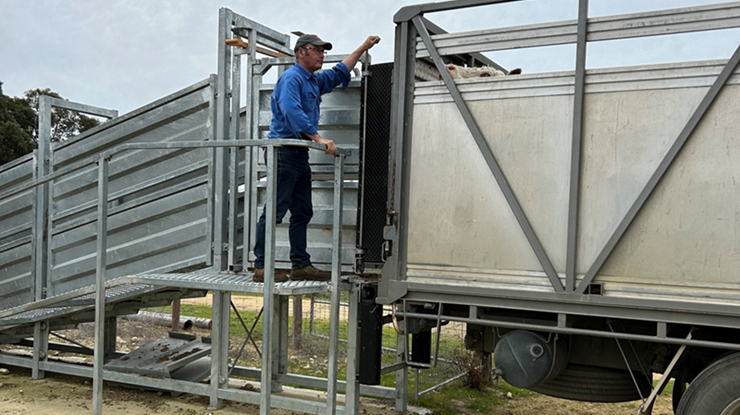 Lachy Day shares his insights into how effective transport preparation can help maintain the condition of your stud bulls and rams. Image: Lachy Day.
Lachy Day shares his insights into how effective transport preparation can help maintain the condition of your stud bulls and rams. Image: Lachy Day.
Key points:
- Producers can help to maintain the condition of their stud bulls and rams by following best practice livestock transport preparation guidelines.
- Priorities should include a cool and comfortable environment, clean and safe equipment/infrastructure and effective communication with transporters.
- MLA's Transport Hub includes all the information producers need to know about transporting livestock in line with best practice guidelines.
When buying stud bulls and rams, Lachy Day from Days Whiteface in SA says preparing for the journey home can help to minimise stress, optimise fertility and keep the animals in the best condition for working.
Lachy and his wife Lou own and operate the stud on their 1,500ha property near Bordertown where they breed Poll Herefords, White Suffolks, White Baldies and Maternal Composites.
According to Lachy, putting livestock transport preparation fundamentals (including the use of trusted transporters, clean trucks and communication with operators) into practise is key, with a few additional considerations for bulls and rams.
Help keep them comfortable and cool
Rubber flooring or sawdust in livestock crates can help to combat leg soreness when carting heavy bulls over longer distances, Lachy said.
"They travel a lot better and it takes some of the vibration and impact out of it," he said.
Animals travelling longer distances may also need spelling to give them time off the truck to rest.
If mature bulls need to be transported together, Lachy suggested using trucks with multiple pens to reduce potential for physical altercations on the truck.
"Boxing mature bulls is fraught with danger," he said.
Air flow and shade are important for animal welfare – particularly in hotter conditions – to minimise stresses on bulls and rams.
"Getting too hot can affect their fertility," Lachy said.
"Semen is produced 60 days ahead of delivery, so it's best to have them transported before that, particularly in hot weather.
"It's best to give them time to get over any stresses to improve their chance of being fertile before they go out to work."
The bigger the change in environment – including temperature, humidity and nutrition – the longer animals need to adapt, Lachy advised.
"Sometimes that may not work but you're better off getting them acclimatised before they need to go out if possible."
Clean and safe equipment and infrastructure
Using clean trucks and not mixing animals in transport can reduce the risk of disease as well.
"It's important for all livestock, particularly rams as sheep are susceptible to more diseases, that trucks are clean and there is no boxing of animals.
"If you take away the chance of contact on the truck that means you're more likely to maintain the health status of the animal to its new destination."
Transport preparation for other livestock is generally applicable to stud bulls and stud rams, Lachy said.
"Facilities are important. Having good safe loading facilities and good safe trucks."
Preparation and communication
Communicating with the transport operator to find out when they will arrive and making sure animals are ready to go is essential.
"Whenever we're using a carrier, we always ask when they would like us to get them in and discuss what type and how many.
"Those transporters are doing it every day of the year."
Best practice guidelines on transporting bulls, including feed and water times ahead of transport, are available from MLA's Transport Hub at mla.com.au/transport-hub.






